 Today we’ll finish up the waistband-zipper-facing section. We’ll understitch the facing, topstitch around the zipper, and secure the facing to the skirt.
Today we’ll finish up the waistband-zipper-facing section. We’ll understitch the facing, topstitch around the zipper, and secure the facing to the skirt.
It’s going to look just about finished by the end of today – only the hem left to complete!
Let’s finish up the waistband. We have three kinds of stitching to do today: understitching, topstitching, and stitch-in-the-ditch stitching.
Understitching
Let’s understitch our facing now! Understitching, if you’re new to the idea, is a line of stitching that secures the facing to the underside and keeps it from rolling to the front. It creates nice, crisp edges that press easily!
Here’s where we left off last time:
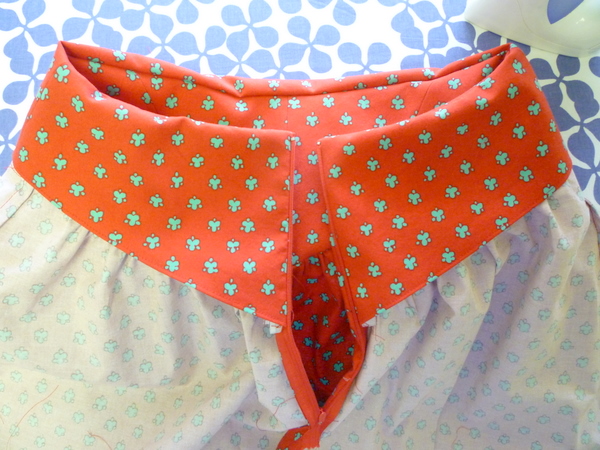
It’s unpressed, but you can see it wants to roll to the right side of our skirts. Let’s stitch it into place!
Arrange your skirt under your sewing machine, so the facing is to the right and the skirt is to the left. Pull the seam allowance towards the right.
Understitch the facing very close to the fold edge, without crossing the fold.
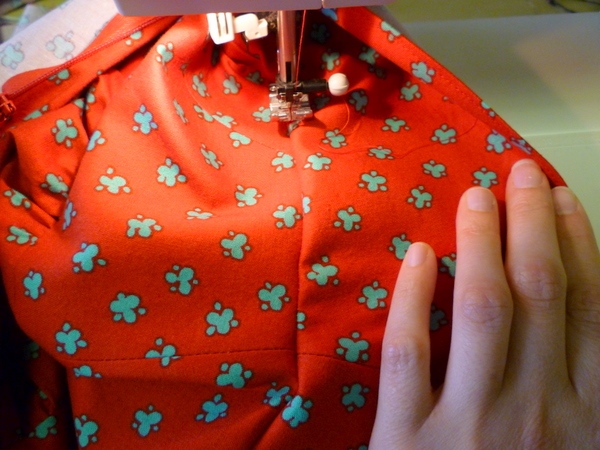
You won’t be able to stitch all the way into the corners, but stitch as close as you can. Here’s how close I was able to get:
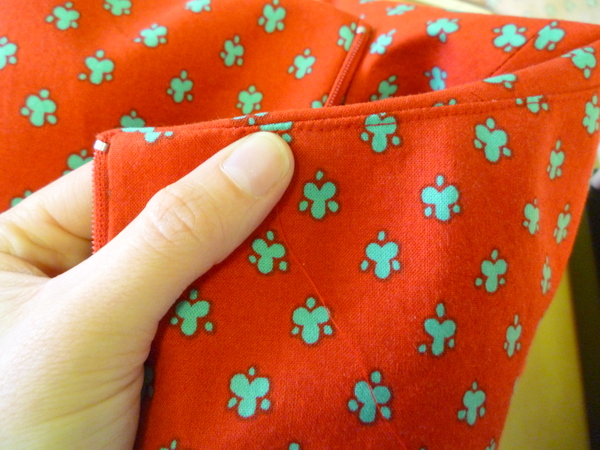
That’s close enough to keep the facing in place! Backstitch at each end, and trim threads.
Now we’ll be able to press the top edge of our skirts nicely.
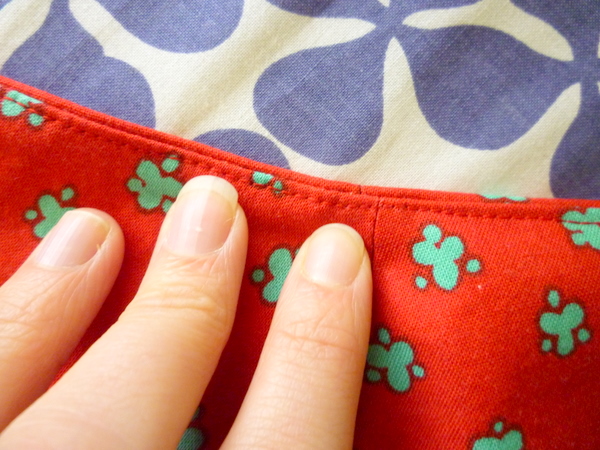 The understitching step is complete! Now, on to the topstitching…
The understitching step is complete! Now, on to the topstitching…
Topstitching
We’ll topstitch around the zipper next. This is for decoration as well as function, it will keep our zipper folds in place and strengthen the zipper opening.
First, let’s press the zipper seam allowances in place. Roll the zipper seam allowances towards centre so that they meet in the middle, and lightly steam or press them in place.
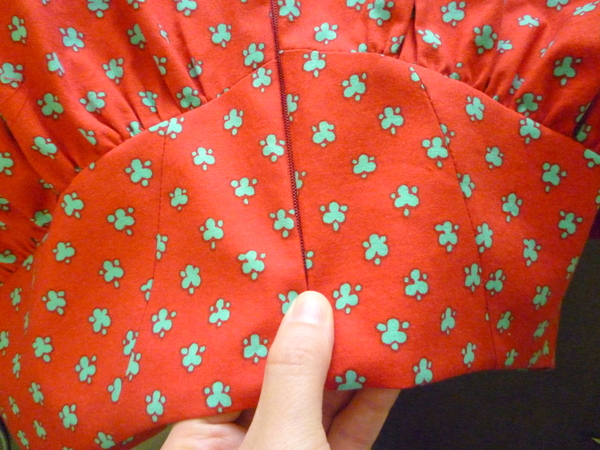 Now, let’s topstitch approximately 1/4″ around the zipper. It’s more important to have even stitching than to have it exactly 1/4″ away, if that makes a difference.
Now, let’s topstitch approximately 1/4″ around the zipper. It’s more important to have even stitching than to have it exactly 1/4″ away, if that makes a difference.
Using a zipper foot, start at the top left and stitch down along the zipper.
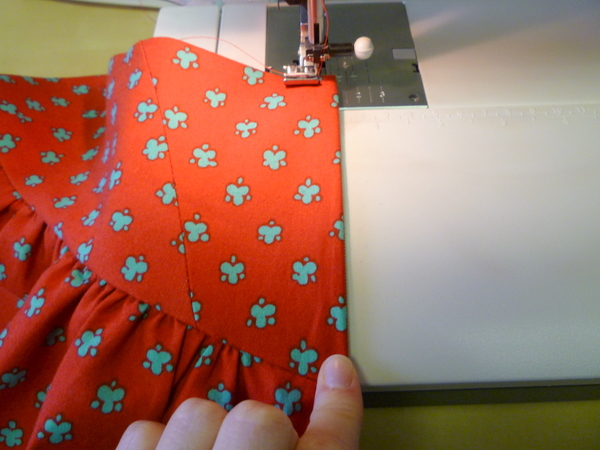 Sew down to the bottom of the zipper, pivot and sew straight across the bottom, pivot again and sew back up the other side of the zipper.
Sew down to the bottom of the zipper, pivot and sew straight across the bottom, pivot again and sew back up the other side of the zipper.
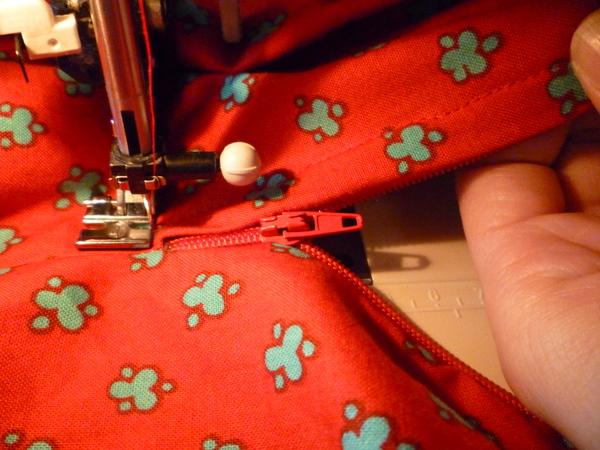 When we go back up the other side of the zipper, I like to close the zipper to make sure the folds still meet in the middle.
When we go back up the other side of the zipper, I like to close the zipper to make sure the folds still meet in the middle.
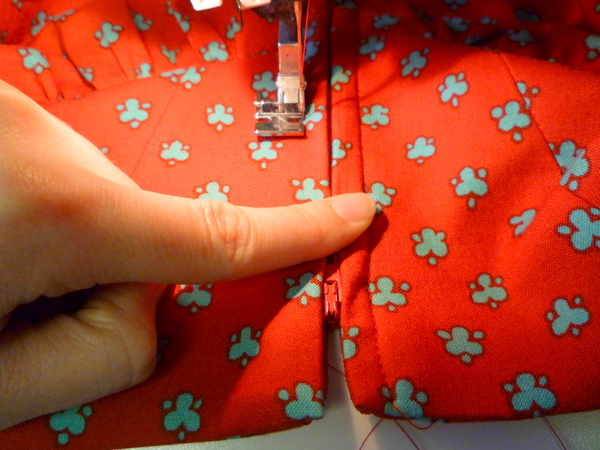 Backstitch at the top of the zipper. Done!
Backstitch at the top of the zipper. Done!
Oh, it’s so pretty! Look at our lovely zipper installation. Finished on the inside, tidy on the outside!
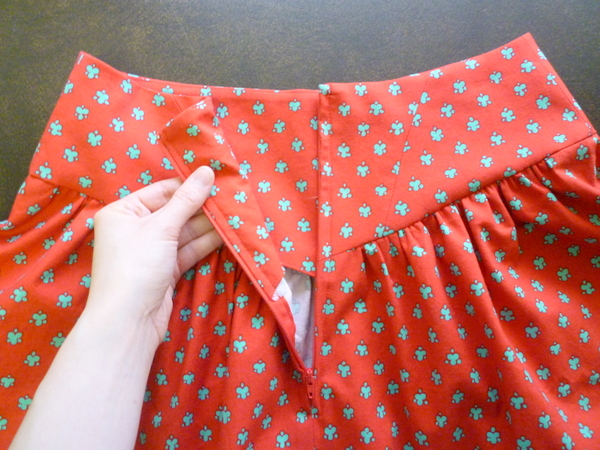 What do you think, was that easier than sewing it the regular way? Our zipper is completely in and we didn’t have to touch a hand-sewing needle.
What do you think, was that easier than sewing it the regular way? Our zipper is completely in and we didn’t have to touch a hand-sewing needle.
Stitch-in-the-Ditch
One last row of stitching and we’re done for the day! I don’t know if there’s another term for stitch-in-the-ditch but that’s what I’ve always called it. Let me know if you call it something else!
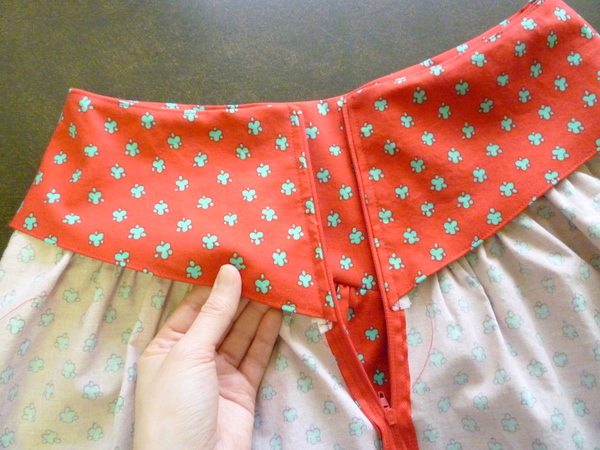 The last thing to do is secure our flopping facing to the skirt. You have a choice here! You can slipstitch it into place so it’s completely invisible. You can topstitch it along the edge of the facing, for a sportier look.
The last thing to do is secure our flopping facing to the skirt. You have a choice here! You can slipstitch it into place so it’s completely invisible. You can topstitch it along the edge of the facing, for a sportier look.
Or, you can stitch-in-the-ditch, it’s as permanent as visible topstitching but invisible like slipstitching.
This is the ditch:
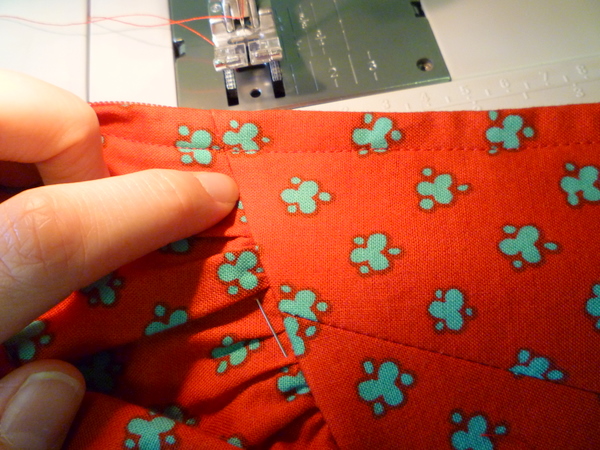 See that little valley between the waistband and the skirt? We’re going to stitch in the middle of the ditch, and hope that our stitches ‘sink’ into the ditch and vanish from sight.
See that little valley between the waistband and the skirt? We’re going to stitch in the middle of the ditch, and hope that our stitches ‘sink’ into the ditch and vanish from sight.
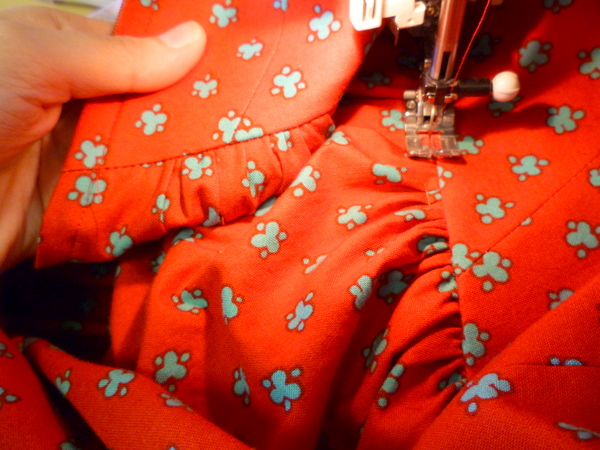 Poke your needle into the ditch, backstitch at the start, and then stitch in the ditch all the way around the waistband. Easy! Just be careful and go slowly, so your stitches stay in the ditch and don’t jump onto the waistband.
Poke your needle into the ditch, backstitch at the start, and then stitch in the ditch all the way around the waistband. Easy! Just be careful and go slowly, so your stitches stay in the ditch and don’t jump onto the waistband.
Here’s what it looks like, from the inside:
 And here’s what it looks like from the right side!
And here’s what it looks like from the right side!
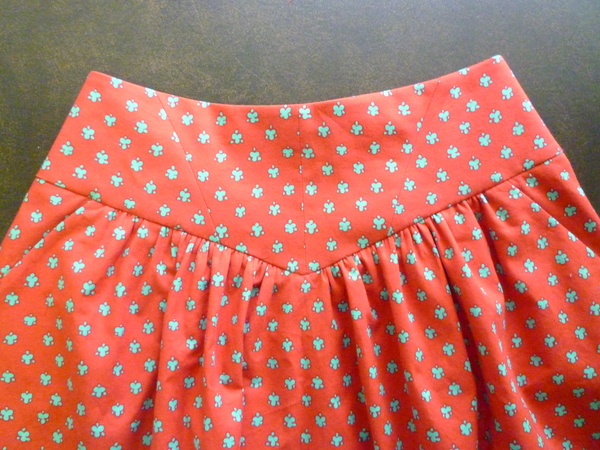 Hurrah! It’s a skirt now. All we have left to do is the hem and we’re done! Go ahead, try it on. I know you want to!
Hurrah! It’s a skirt now. All we have left to do is the hem and we’re done! Go ahead, try it on. I know you want to!

Wow. I never knew about stitching in the ditch. Thank you!
I always have trouble stitching in the ditch…it’s inevitable that I will have a portion that doesn’t quite get caught or I’ll get a little tuck in the facing. :-( Especially on knits, since they stretch.
Thank you for sharing this information. I love seeing the pictures, I am so visual. I am getting back to sewing my own clothes again after being a longarm machine quilter for 5 years. I miss sewing. My longarm is leaving in 2 weeks and then I get back to me…no more customers!! This is very inspiring for me. Thank you! Thank you!!
Thanks Tasia. I have heard of stitch in the ditch but have been too nervous to try it yet. I’m now free to start my Crescent skirt so I’ll get tracing. (Yes I’m way behind!)
Your sewing is so neat and professional. Thanks for all thos awesome tips.
The stich-in-the-ditch was tedious to do, I didn’t dare use the foot pedal at all and went very slowly just by turning the hand weel. Still, it’s not invisible. I had already topstitches the waistband at the bottom or I should have prefered to do it at this point. I will remember this for the next one.
Just finished my first skirt: http://www.flickr.com/photos/8503531@N08/5749792103/in/photostream
Thank you for a great sew along!
Oh I’ve missed a bit, my centre back seam still isn’t sewn up! When was I suppose to do that? I put the zip on the facing and then sewed the facing to the waistband but didn’t sew all the way to the bottom of the skirt! Oops. Guess I need to go back and to that. Also having a problem sewing the top of the waistband, but thats my own doing. I’ve unpicked the seam and need to re do.
Thanks and I’m glad this was helpful! No rush, for anyone who’s not this far along on their skirt. Sew at your own pace, when you’re feeling inspired!
@Louise: Ooops… I swear I wrote about the centre back seam, but I may have missed it! So sorry if I did, I’ll go back and check.
You’ll need the centre back seam sewn up before starting to sew the zipper in. So sorry for the confusion!
@julia: It’s so cute! You did a lovely job!
@julia: depending on your fabric, sometimes it’s more invisible than other times! Really flat, smooth fabrics don’t hide the stitching well. Something textured, or flannelly or wooly will help the stitches sink into the ditch. Sorry you had so much trouble! I like the technique but it’s not everyone’s favourite.
@Mary Beth: Hurrah! Welcome back to sewing for yourself!
@CGCouture: Hm, I don’t sew knits very often myself so I don’t know what to suggest, I find it all depends on the fabric. If I was really having trouble, I’d skip the ditch-stitching altogether and go for obvious topstitching!
I completely sympathise with anyone struggling with stitching in the ditch. I was just happy that I tend to sew with patterned fabrics so any wandering stitches tend to be hidden in the pattern. I then discovered that for some sewing machines there is actually a special foot just for this purpose. For my machine (a Brother) it’s called an edge-joining foot. It is basically a foot with an unsharp blade attached to it that helps to separate the two edges of the fabric. I think for some machines it is called a stitch in the ditch foot. I also discovered, before buying a dedicated foot just for this purpose, that a blind hemming foot can also be used, but on my machine it has a tendency to bunch the fabric up behind the foot, so I prefer the dedicated foot.
When I first got my machine I only ever used the extra feet for the purpose to which I thought they were intended, but one day I started playing around with them and found other uses, such as the above use for the blind-hemming foot. It is definitely worth having a search around the net for your own sewing machine and its feet to see how else they can be used, other than the strict use mentioned in the sewing-machine manual. For example, you can use a blind-hemming foot or my above mentioned edge-joining foot for very even top-stitching. After mentioning this to my mum, she used her blind-hemming foot to make perfectly straight pintucks in a cushion cover by using the foot blade as a guide for the edge of her fabric, setting the needle off to the left slightly.
Simply put – play with your feet :)
Julie
Hi Tasia. I’m not sure if my facing is going to be long enough to catch the stitch in the ditch. I finished my facing by turning it under. Maybe I turned it over too much. Something to think about for my next one – whether to make the waistband facing slightly longer?
@Sewingdina: Hello! I see you have a bunch of question comments and I’m working on answering them.
There’s an extra 5/8″ (1.5cm) extension between where the waistband seamline ends, and the edge of the facing. Unless you turned under the whole 1.5cm extra, there should be enough to catch in the ditch! Try pinching the waistband at the top edge, and smoothing down the facing. It’s easy for it to get bubbled up, you’ll want it to be super-flat before stitching in the ditch.
You can slipstitch, for an invisible look, especially if you’re not sure if your edge will catch. Or, you can baste it first and then ditch-stitch. That way, you’ll be able to see if your edges will catch, before getting it under the machine and having to un-pick your work. I hope this helps!
Thanks Tasia. Once it was all ironed and flattened there was enough room for the stitching. Panic over! I haven’t sewn the facing down yet but I’ll follow your basting advice to make sure it’s flat.